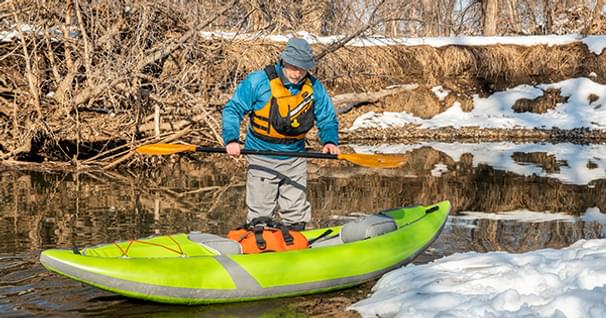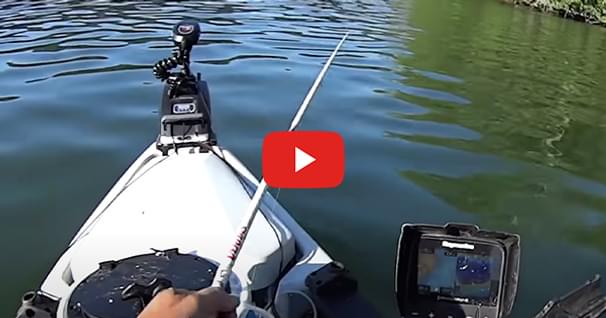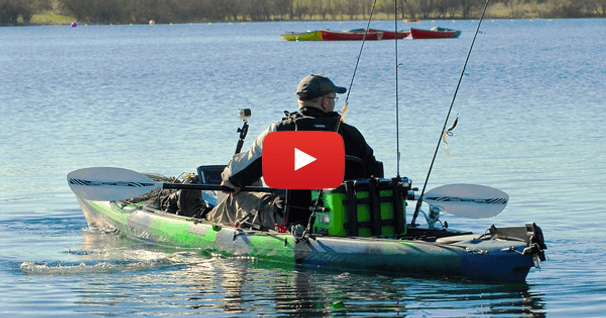What's Around The Bend?
Round the bend you see the dancing horsetails of the rapid. As is the stern's prerogative, you command the bow to "brace" so you can stand for a better look. The way ahead looks clear so you settle to your knees and head towards the slick water vee which defines the route. Suddenly, a huge rock pillow looms out of nowhere; the bow misses his cue, draws too late, and the tottering craft dives into the yawning hole below. Capsize! Seconds later, paddlers and gear are immersed in the chilling grip of moving water.
This irresponsible scenario is played again and again on rivers everywhere. Canoeists approach a drop, survey it briefly from above, then dash jubiliantly downstream. More often than not, luck prevails and everyone simply has a splashing good time. But not always. As this classic case illustrates, unplanned upsets can be serious.
Whitewater thrill seekers take to the river as soon as the ice melts in early spring. Clad in wet (or dry) suits and helmets, and secured to their boats with thigh straps and toe blocks, they play confidently in drops that flatwater canoeists portage around. Fast forward turns into eddies are the rule. They use "bow upstream" procedures to cross severe currents. Rarely do they backferry around curves or into eddies.
Even if you don't paddle serious rapids, you'll benefit by knowing the ways of whitewater sport paddlers. But keep an open mind as you learn, for what works best in a short, rockered canoe often fails miserably in a long backwoods cruiser. There's a proven method to getting safely down the rapids of an unfamilar river. Here, in no particular order, are the rules for safe passage:
1. When you see the dancing horsetails of a rapid, put ashore immediately, on the inside bend of the river and scout the entire drop (things look differently from shore!) Shorelines are often brushy and difficult to travel so this procedure is not always easy to follow. Often, you may have to horse your way through shoulder-high willows, jump from rock to rock or cross a patch of knee-high mud, all the while sweating and swatting hordes of mosquitoes and black flies. Nonetheless, you must avoid the temptation to abandon looking and just "go for it", even on a river you have paddled many times. Indeed, "familiar rivers" may be the most dangerous ones of all, as the following case illustrates:
It was my fourth descent of Saskatchewan's Fond du Lac River. The "always canoeable" class III rapid was etched clearly in my mind. Begin far right, clear the narrow chute below, then pivot quickly upstream and ferry across to river left. Just before crashing the bank, turn down current and catch the yard- wide slot near shore. High water will make the run easier, but it's possible if there is any downstream flow. Still smarting from the hurt of wrapping my Mad River Explorer earlier that summer (on a river I'd done five times before!), I decided to walk the right bank and check for obstacles in the ferry path. There were none. However, to see the negotiable slot, I'd have to ferry across the river then walk 200 yards on precarious boulders. Why mess around for 30 minutes to ascertain what I already knew? Hadn't I faithfully walked the right shore and satisfied the need for caution? After all, I'd safely run this rapid three times before. Further checking would surely be a waste of time.
Or would it? In a far corner of my mind, my consciounce begged the need for caution. Should I heed the call and take the time to scout? Longingly, I stared at the blind spot which marked what past experience had revealed was a clear channel. Again, I remembered my upsetting experience earlier that year. Time be damned: I would not run this rapid until I checked the chute!
Dutifiully, I ferried across the prancing rapid and tied up to the gnarled bole of a wind-beaten spruce. Numbly, I boulder-hopped to the final drop, confident I was in for no surprise. Then I saw it--a two inch trickle of water marked the vee of the "always canoeable" chute. Horrified at what might have been, I mentally played out the scenario: Coming out of the fast forward ferry, we'd spin downstream into nothingness and capsize in the heavy water which pounded the boulder line below. There simply was not enough water for a clean run. It took less than five minutes to line my canoe to safe water below.
If I could teach just one skill to those who paddle straight-keeled cruising canoes down fast moving rivers, it would be the backferry. In this technique, paddlers maintain a downstream attitude and angle their canoe about 30 degrees to the current--tail pointing in the direction they want to go. As they paddle backwards,the canoe moves sideways (no downstream motion) across the river to the safety of an eddy. You'll find the rules of playing this vector game in every basic river canoeing text.
Hot dog whitewater paddlers do not backferry. Instead, they spin their lightweight slalom canoes upstream and dash across the river from eddy to eddy. Try this in a lively rapid with a heavily loaded tripping canoe and you're in for a big surprise! Better to point the bow of your boat downstream and slowly backferry around obstacles. Granted, backferrying lacks the dynamic appeal of pivotal, bow upstream maneuvers. But it is the safest way to get off the river when you're piloting a big sluggish canoe.
It follows that you should always ferry to the inside bends. Rivers run faster on the outside curves and all the waves pile up there. And if you have to portage, the inside bend defines the shortest distance between points--the reason why established carries are alsmost always found here.
The forward ferry is the opposite of the backferry. Same procedure, only the attitude of the boat is reversed. If, after checking the rapid on the inside bend, you can find no safe passage, line your canoe upstream a safe distance above the rapid, then turn the boat around so the bow points upriver. Hold a 30 degree angle to the current and paddle forwards. If the angle is correct, the craft will move to the other side of the river without sliding downstream. The forward ferry is more powerful than it's backpaddling cousin, but you need space and time to perform this maneuver if you're paddling a stock tripping canoe.
In 1982, friends and I experienced a polar gale along the remote Hood river in Canada's Northwest Territories. for three days we were confined to our tents by 55 mile per hour winds (yes, we had a wind gauge!) and unrelenting rain. When the weather cleared, we were greeted by a silt-choked river in flood stage, the hydraulics of which were unbelievable. There were uprooted dwarf willows and debris everywhere in the river and they all piled up on the outside curves. The powerful current, which we estimated at more than ten miles an hour, produced man-sized waves at the outside of every bend. In many places, the river was more than a quarter mile wide!
Getting downstream that day was a matter of staying tight on the inside bends, away from the debris and engulfing whitewater. First, we'd ferry ;furiously to reach a right bank, only to ferry back across the channel when the river curved left. I don't know what we would have done without our well-practiced ferries. Here are some other rules for safe passage:
1. Equip each end of your canoe with 25 feet of brightly colored, braided polypropylene rope (it floats) so you can line the boat around obstacles in the river. Keep lines coiled and secured under a loop of shockcord on the decks when they're not in use.
2. Learn to identify ledges (falls) from above by the "obstacle height comparison method"--that is, visually compare the height of shoreline trees, boulders, canyon walls etc., which dot the shoreline with those that are downstream. I am always amazed when I hear stories about canoeists who paddled over a dam because they "didn't know it was there". A significant drop is almost always visible as a "cut-line" from above.
3. Learn to separate the sound of a gentle drop from the roar of a dangerous one. As you develop an "ear" for whitewater, you'll discover that a substantial upstream wind can magnify dangers while a downstream wind can minimize them. That's why you must always scout all but the easiest rapids before you run them.
4. If the water is very cold or the river is very wide, try to run the rapid as close as possible to ashoreline. Capsize in 50 degree water in the middle of a 100 yard wide river and you'll understand the need for caution.
5. Many backcountry trippers apply the "nine out of ten" rule before they commit to a rapid. That is, can you successfully run this drop nine out of ten times? If not, best portage.
Scenario: your partner wants to run the rapid. You don't. Here are some tricks you can use to support your position.
"Well, John, it's your boat. I won't take responsibility for what it looks like when we reach the bottom."
Conversely, "Sorry, John, it's my boat. I can't afford to buy another one!"
Or best of all: "I trust you, John, but I don't trust myself. I'm not up to this and I don't want to let you down."
6. Whitewater novices are often overwhelmed at the size and complexity of a long, thundering rapid. At first look, there seems no alternative but to portage. But once you learn to dissect the rapid into "manageable pieces" by scouting each obstacle from eddy to eddy, options abound.
For example: perhaps you can get around the drop by executing a variety of maneuvers. Run to the eddy on the left then drag over the rocks to the clear channel at right. Then, line down through the shallow rock garden to the clear vee, then run to the next eddy. Tie up here and have a closer look at what's downstream. This "bits and pieces" approach pays rich dividends in negotiating long rapids which continue around bends.
In summary, hug the inside bend (a reliable backferry is essential!!) when you hear menacing rapids. Then, put ashore and scout! Respect rivers you’ve done before: complacency can be deadly--high water, low water and strainers (downed trees) create new hazards. Learn to identify the roar of bad rapids and the sight of lethal ledges. Finally, apply the nine out of ten rule before you run any rapid. If in doubt, portage! *
*See my flagship book, CANOEING WILD RIVERS, 5th Edition, for more detailed information on running rapids.
Related Articles
Flexibility is always a good topic of discussion when it comes to kayaking. Depending on our style of…
Kayak Catfish does some trolling with crappie magnets to catch some catfish bait.
How many of you have ever heard that paddle craft (vessels under oars according to the Navigation Rules)…
More times than not, the reason you aren't catching big fish is not because you aren't doing enough…



